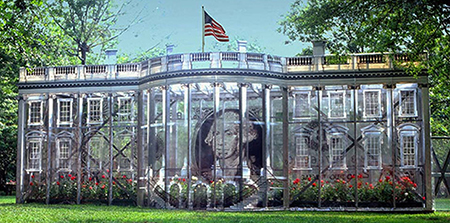
Thanks to Stacey Abrams and her hardworking team, as well as to multitudes of volunteers who wrote letters and participated in phone banks, Georgia has finally turned blue. Also deserving some credit, at least in his role as a cheerleader working to motivate potential voters, is San Antonio artist David Alcantar, who ran, marathon style through the streets of three Georgia counties from January 3-5, wearing a Superman costume and carrying a large flag with the word ‘VOTE!’ Alcantar’s four mile run on Runoff Election Day was indeed noticed, because a picture of him in motion appeared in the “Atlanta Journal-Constitution”. Entitled “The American (in Georgia),” the artist’s get-out-the vote performance was the logical follow-up to “The American”, a similar undertaking in San Antonio that commenced on October 13, the first day of early voting in Texas. For that project, Alcantar ran three miles a day in local neighborhoods through November 3. Both runs are part of his ongoing research-based “Superman Project,” which, following the election of Donald Trump, began in an effort to understand how two diametrically opposed cultural figures — one devoted to “Truth, Justice, and the American Way,” and the other to lies, hatred and “Make America Great Again” — could both be so widely embraced as “heroes” by masses of Americans.
In addition to his performances, Alcantar has produced a number of thought-provoking works on paper in which he mixes up the identities of Superman and Trump. In “High Aims (Target): Power is not Heroism,” a triumphant looking Superman with Trumpian facial features is superimposed over the Presidential seal, accompanied by a word bubble containing Trump’s March 13th assertion, “I don’t take responsibility at all” for Covid. In Alcantar’s rendering, Trump is quite accurately portrayed as reveling in power, but failing to accept the duties that come with it.
In “Identity Politics #2,” Alcantar reveals an intriguing bit of Superman history. In a comic book edition of “Superman” that ironically hit the stands one week after the assassination of John F. Kennedy, the superhero reveals his secret identity as Clark Kent to JFK and tells him, “If I can’t trust the President of the United States, who can I trust?” Alcantar’s mixed media drawing includes a collaged section from the vintage comic book and two drawn replications of it in which JFK is replaced by Trump. In a clever juxtaposition of the hero and anti-hero, the upper panel repeats the original text, while in the lower half, Alcantar quotes Trump from the Hollywood Access tape.
Within the context of contemporary art history, it is relevant to note that Alcantar is not the first to don Superman garb for consciousness raising performance art. From 2001-2009, Pope.L, who is known for labor intensive “crawl pieces,” enacted “The Great White Way,” for which he traversed the entire 22 miles of Broadway, the longest street in New York City, on his elbows and knees while wearing a capeless Superman outfit, gardening gloves, and a skateboard featuring a Superman logo strapped to his back (which helped him get through intersections more quickly by turning over and moving in a supine position). Over nine years, the performance took place in short segments that usually amounted to distances of about six blocks, at which point he was usually exhausted.
Pope.L began his crawl pieces in 1978 with the idea that traveling painstakingly in a horizontal position is a perfect metaphor for the underprivileged, those who are deprived of verticality, i.e. standing upright, which he sees as representing financial security and good health. In that he is African American, these works focus attention primarily on the largely predetermined plights of Black people in a society controlled by Whites, many of whom are racist. For Pope.L, the Superman costume served the dual purposes of bringing some levity to the project, while also ensuring that onlookers would take notice without automatically assuming that he was simply your everyday New York homeless person.
Humor is more directly expressed in another performative Superman project undertaken in 1995 by New Orleans artist Blake Boyd, who photographed Warhol Factory superstar Taylor Mead wearing a Superman costume in a public photo booth. While in his twenties, Boyd went to New York City and befriended Mead and his Factory compatriot Billy Name, who also posed for photo booth photos, in his case dressed as the mythological Thor. Boyd chose Superman for Mead’s persona because he wanted to pay homage to Warhol, who introduced Superman into his art in the early 1960s and also included him in his 1981 “Myth” series. Boyd’s intention was to portray Mead as an elder superhero who has passed his prime, although Mead’s penchant for hamming it up is very much visible in the photos.
Coincidentally, another pop culture icon portrayed in Warhol’s art has been impersonated in performances that, like Alcantar’s, involved voter motivation efforts. In 1995-96, Karin Giusti adopted the persona of Jacqueline Kennedy Onassis in conjunction with her installation “White House/Green House,” which debuted at Real Art Ways in Hartford, Connecticut before moving to Battery Park in Lower Manhattan. Conceived as an exploration of the relationship between money, politics and the future of the environment, the installation was a functioning greenhouse in the shape of the White House, with an enlarged dollar bill image on its façade and the White House on the back. Giusti used alternative energy sources to maintain fifty rose bushes (several named for U.S. presidents) and set up a kiosk with voter information and leaflets on new energy options. Periodically throughout each exhibition, she appeared in the guise of Jacki O., personally handing out voter registration forms. Subsequently, she introduced a smaller mobile version, attached it to a biodiesel truck fueled by vegetable oil, and took her Jackie O. show on the road in the election cycles of 2004, 2008, and 2016.
